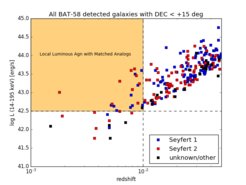Nearby AGN and the LLAMA Project

The Big Picture
The existence of relations between supermassive black holes and the stellar velocity dispersion, luminosity, mass, and light concentration of their host galaxies has been a major discovery of the last decade. These correlations imply that black holes and their host galaxies co-evolve, and have resulted in a widespread observational and theoretical effort to understand their physical origin. Grasping this co-evolution has become one of the most important challenges of modern astrophysics. A plausible mechanism capable of linking the innermost nuclear region to the whole galaxy is the feedback outward from an accreting black hole (an active galactic nucleus or AGN) to the host galaxy. Equally important is the flow of gas inward from the host galaxy to the central regions where it can trigger star formation and eventually fuel a massive black hole. It is on these aspects that our work focusses.
AGN in the Local Universe
Many studies of AGN, particularly those concerned with understanding the co-evolution of black holes and their host galaxies through cosmic time, rely on observations of quasars. The reason is simply that these are the most luminous of such objects and can be studied at all redshifts. While they form an important component of the AGN population, the number density of lower luminosity AGN is orders of magnitude greater. This is particularly true in the local universe because of the effects of downsizing, which means that at low redshift black hole growth occurs primarily in Seyfert galaxies, with black hole masses < 108 Mʘ and moderate luminosities. This has important implications. Although most quasar activity may result from mergers of gas-rich galaxies, Seyfert nuclei typically reside in disk galaxies and are likely to be fuelled via secular processes associated with disk evolution.
Gas Inflows and Outflows and Starbursts in Seyfert Galaxies
It is understood how spirals and bars in disk galaxies can drive gas in to the circumnuclear regions on kiloparsec scales. However, it is still far from clear under what conditions the gas can be transported inward to the nuclear region and what happens to it once it gets there. By analyzing detailed observations that use instruments we have designed and built in-house, our aim is to understand the following questions:
- How does gas flow in from kiloparsec scales to the central tens of parsecs?
- How prevalent are outflows in AGN? When are they molecular and how do they connect or entrain the surrounding gas?
- What are the properties of the starbursts the gas triggers there?
- What is the impact of these starbursts on the flow of gas to smaller scales?
- How is this all related to the molecular obscuring torus that can hide the central AGN?
- Are the AGN in mergers fed by similar or fundamentally different processes?
The LLAMA Project

The AGN phenomenon is likely short-lived. Statistical evidence, e.g., from the fraction of X-ray bright, optically normal galaxies (XBONGs), as well as hydrodynamical simulations indicate that a particular AGN phase may only last for as little as 105 years. It is therefore not surprising that little differences between the host galaxy properties of active and inactive galaxies are found when assessing, e.g., the host galaxy morphology which will only change within dynamical times much larger than the AGN timescale. We have therefore set up a unique study to compare the nuclear inventory of AGNs and inactive galaxies in a comprehensive way. For this we first selected the 20 most luminous local AGNs based on the sensitive ultra-hard X-ray all-sky survey provided by the Swift/BAT satellite. The rationale for this selection is to only select AGNs where coherent inflow mechanisms are required due to the large luminosity or mass accretion. We further require the galaxies to be local in order to resolve the nuclear region, in particular the nuclear stellar cluster on scales of 50 to 100 parsec. Finally, we employ the ultra-hard X-ray band to be largely unimpeded by obscuration, which can severely affect AGN selection based on optical properties.
The AGN sample selected that way is accompanied by a sample of inactive galaxies (where no ultra-hard X-ray emission has been detected) whose host galaxy properties are matched to the active sample. This selection of 39 galaxies in total have been observed with VLT/X-SHOOTER, VLT/SINFONI, APEX as well as ALMA and HST.
Team and Collaborations
The following people are part of the core LLAMA team.
Ric Davies (MPE), Thaisa Storchi-Bergmann (UFGRS, Brazil), Leonard Burtscher (Leiden Observatory), Reinhard Genzel (MPE), Erin Hicks (University of Alaska, US), Mike Koss (Eureka Scientific, US), Ming-Yi Lin (ASIAA, Taiwan), Dieter Lutz (MPE), Witold Maciejewski (Astrophysics Research Institute, Liverpool, UK), Francisco Müller-Sánchez (University of Memphis, US), Gilles Orban de Xivry (Université de Liège), David Rosario (Durham University, UK), Rogemar A. Riffel (UFSM, Brazil), Rogério Riffel (UFGRS, Brazil), Marc Schartmann (MPE), Allan Schnorr-Müller (UFGRS, Brazil), Amiel Sternberg (Tel Aviv University, Israel), Taro Shimizu (MPE), Eckhard Sturm (MPE), Linda Tacconi (MPE), Sylvain Veilleux (University of Maryland, US), Turgay Caglar (Leiden Observatory)
Publications
Please have a look at our ADS Library for an up-to-date list of our main publications.

